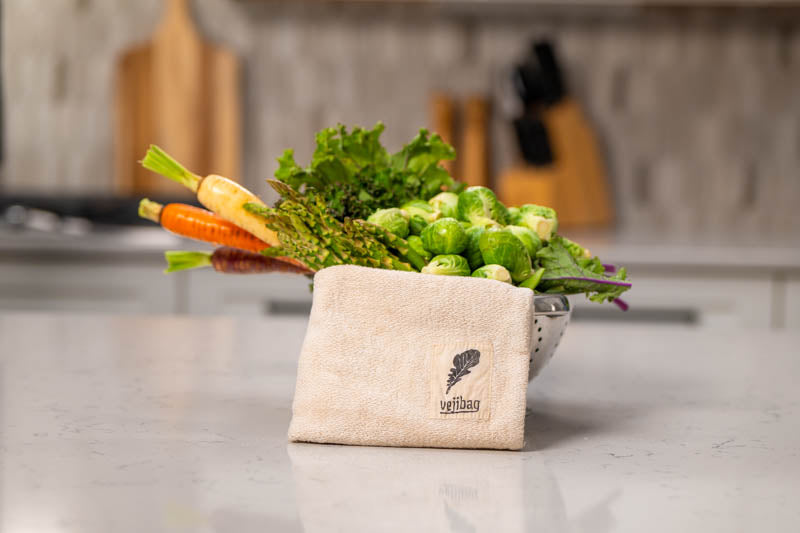Want to go all in on produce productivity?
Let's nerd out together.
We love talking veggies! Have questions or want to know the best way to keep your veg fresher, longer? Contact us!
How to Vejibag
How do you use a Vejibag?
Using Vejibag is super easy. Just wet it, bag it, crisp it!
Wet the bag and wring out excess water.
Then, rinse your vegetables carefully, remove any damaged areas, and gently shake off any excess water. If you're washing lettuces or greens, there's no need to spin. Let your Vejibag do the work!
After that, just pop it in the main compartment of your fridge.
How does Vejibag work to keep veggies fresher?
Moisture works the magic. The same way that cut flowers stay fresher, longer with a vase of water, veggies do the same thing in a cool, moist environment.
How wet should my Vejibag be?
Vejibags should be damp but not dripping wet. The fabric is very absorbent. When you run it under the tap, let it soak in water and then lightly wring it out so that it is still holding water, but not dripping all over your counter. Put your veggies in and put it in the fridge.
How can I refresh my Vejibag if it dries out?
A spray bottle is a great way to refresh a Vejibag to prevent it from drying out. Alternatively, you can remove the contents of your Vejibag and use the tap again to dampen and then wring out your bag.
Where in my fridge should I put Vejibag?
Store in the main compartment of your refrigerator or in a slightly opened crisper drawer. When the bag dries out after several days, re-wet slightly by running it briefly under the faucet, vegetables and all.
Fun fact! Most people don’t realize that your fridge can be set at a pretty cool temperature to keep veggies fresh – just above freezing. Check with a thermometer to know for sure what temp your fridge is at.
If you want to get super nerdy with us 🤓 –here's a chart with the optimal storage conditions for many different kinds of veggies.
My veggies are still going bad! What am I doing wrong?
Fun fact – a lot of people's fridge temperature is too high! It is likely that you need to check the temperature in your fridge to ensure that it is cool enough. For the best storage of most vegetables, temperatures just above freezing (32 degrees) are optimal.
Re-wet your Vejibag when it dries out to make sure it's still providing the moisture your veg needs to stay fresh.
Many of our customers are surprised to learn that the area of the refrigerator where they are storing produce is warmer than they realized. If you have a thermometer, even just an outdoor thermometer, placing it in the space where you store your vegetables.
If you want to get into the nitty-gritty, check out this chart for the ideal temperature and humidity conditions for storing specific fruits and vegetables.
What To Vejibag
What kind of veggies can I put in Vejibag?
Most veggies that you put in the fridge will like Vejibag! Here's a quick guide.
YES TO VEJIBAG
✅ Leafy greens
✅ Herbs
✅ Squash
✅ Peppers
✅ Squash, Zucchini & Cucumbers
✅ Root vegetables
✅ Green beans & peas
✅ Brassicas
Can I put different types of veggies in the same bag?
Yes! Different types of produce can certainly be mixed in your Vejibags.
Many customers like to keep certain items together based on what they use together.
Personally, we prefer to keep our leafy greens, especially delicate loose salad greens in their own separate bag(s) so that we don't have to go weeding through for other bulkier items!
Do I have to wash all my veggies before I put it in the bag?
It's up to you! We have customers who prefer to wash everything first, as well as some who wash later right before use.
If transferring from an already bagged product, we do recommend washing the veggies and removing any wilted leaves, shaking out excess water, and then placing the produce in the bag.
Can I put in pre-cut vegetables?
In short, yes—cut vegetables stay fresher, longer in Vejibags. Some of our favorite examples include apple slices, baby carrots, cucumber slices, bell peppers, and leftover salad mix (without the dressing).
Vejibag is great for food prep! Make your own "salad in a bag" for quick weeknight meals.
That other half of the apple you didn't finish, or the extra pepper slices you want to save for later? Throw them in a Vejibag to make them last longer!
What about squash? Herbs? Berries? Tomatoes? Mushrooms?
Squash... yes! Squash loves the extra moisture provided by Vejibag.
Herbs... yes! Even cut herbs work great in your Vejibag.
Berries... not so much. Berries don't need as much moisture to stay fresh. Hardier fruits like apples and grapes are good to Vejibag, though!
Tomatoes... not so much. Tomatoes in general are best kept on a cool, dry countertop.
Mushrooms... not so much. Mushrooms like to stay dry until used.
For a full list of what works in Vejibag, click here.
Wash Your Vejibag
Is the bag machine washable? Should I wash the bag between uses?
Yes! Vejibags are machine washable and dryer-friendly. We recommend that you turn the bags inside out and launder with fragrance free detergent. Hang in the sun to dry or machine dry.
We do recommend laundering or hand washing Vejibags between uses with a fragarance free soap or detergent.
To sanitize the bags, we recommend a hot dryer or air drying in the sun. This allows potential contaminants to get washed away before introducing fresh vegetables.
Machine washing and drying will cause about 10% shrinkage, as Vejibags are made from 100% cotton - but don't worry - the bags will stretch right back out again when they get wet!
How long does Vejibag last? What can I do with them when they're not usable anymore?
With proper care, you can expect your Vejibags to last for years. Once you feel that your Veijbag has done it's time and is worn out beyond use, you can actually compost it since it is made from 100% nontoxic biodegradable material.
Many of us have found that cutting it up and turning it into rags for other purposes works well too!
I have spots and stains on my Vejibag. Help! What is causing this? How do I get rid of them?
Over time, some staining is bound to occur with use as blemishes on your produce come into contact with your bag. To get stains out, we recommend soaking Vejibag in distilled vinegar and hot water and then laundering. For more stubborn spots and stains, you can soak the bags in a mixture of hydrogen peroxide and hot water or use your favorite oxygen bleach, before laundering the bags.
Fun fact – a lot of people's fridge temperature is too high! Most molds will not grow at temperatures below 39 degrees. It is likely that you need to check the temperature in your fridge to ensure that it is cool enough – just above freezing is good for most veggies!
If you want to get into the nitty-gritty, check out this chart for the ideal temperature and humidity conditions for storing specific fruits and vegetables.
Still have questions?
We love to talk about veggies! Send us an email to tell us what's on your mind and someone from our team will get back to you as soon as possible. If you have a question about a specific order, please include your order number.
Please email us at info@vejibag.com.



